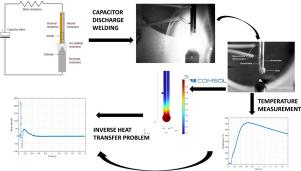电容放电焊接中热电偶测量误差对热速率估算的影响
IF 5
2区 工程技术
Q1 ENGINEERING, MECHANICAL
International Journal of Thermal Sciences
Pub Date : 2025-09-24
DOI:10.1016/j.ijthermalsci.2025.110324
引用次数: 0
摘要
精确的温度测量对于电容放电焊接(CDW)等高度瞬态过程的建模和控制至关重要,在这些过程中,传统的传感器可能会引入显著的误差。这项工作探讨了在这种情况下,不同的热电偶测量策略如何影响热速率估计的准确性。分析了两种实验设置:一种使用30个AWG热电偶,采样时间为90毫秒,另一种使用40个AWG热电偶,采样时间为4毫秒。建立了一个精细的三维瞬态热模型,明确地包括传感器珠的几何形状和热电偶导线中的焦耳热效应。采用非线性函数规范法对焊缝处的未知热率进行了估计。对比结果表明,改进的传感器选择和更高的采样率减少了残余误差,提高了反传热问题的解的稳定性。研究结果强调了测量设计和热模型细节对高瞬态热条件(如CDW)反解可靠性的关键影响。此外,在模型中包含热电偶珠的几何形状是一种有效的替代方法,可以最大限度地减少通常与基于接触的温度测量相关的误差。本文章由计算机程序翻译,如有差异,请以英文原文为准。

Impact of thermocouple measurement errors on heat rate estimation in capacitor discharge welding
Accurate temperature measurement is critical for modeling and controlling highly transient processes such as capacitor discharge welding (CDW), where conventional sensors may introduce significant errors. This work investigates how different thermocouple measurement strategies affect the accuracy of heat rate estimation in such conditions. Two experimental setups were analyzed: one using 30 AWG thermocouples with 90 ms sampling, and another using 40 AWG thermocouples with 4 ms sampling. A refined three-dimensional transient thermal model was developed, explicitly including sensor bead geometry and Joule heating effects in the thermocouple wires. The unknown heat rate at the weld bead was estimated using the nonlinear Function Specification Method. Comparative results demonstrated that improved sensor selection and higher sampling rates reduced residual errors and enhanced solution stability in the inverse heat transfer problem. The findings highlight the critical influence of measurement design and thermal model detail on the reliability of inverse solutions for highly transient thermal conditions such as CDW. Additionally, the inclusion of the thermocouple bead geometry in the model was presented as an effective alternative to minimize errors commonly associated with contact-based temperature measurements.
求助全文
通过发布文献求助,成功后即可免费获取论文全文。
去求助
来源期刊

International Journal of Thermal Sciences
工程技术-工程:机械
CiteScore
8.10
自引率
11.10%
发文量
531
审稿时长
55 days
期刊介绍:
The International Journal of Thermal Sciences is a journal devoted to the publication of fundamental studies on the physics of transfer processes in general, with an emphasis on thermal aspects and also applied research on various processes, energy systems and the environment. Articles are published in English and French, and are subject to peer review.
The fundamental subjects considered within the scope of the journal are:
* Heat and relevant mass transfer at all scales (nano, micro and macro) and in all types of material (heterogeneous, composites, biological,...) and fluid flow
* Forced, natural or mixed convection in reactive or non-reactive media
* Single or multi–phase fluid flow with or without phase change
* Near–and far–field radiative heat transfer
* Combined modes of heat transfer in complex systems (for example, plasmas, biological, geological,...)
* Multiscale modelling
The applied research topics include:
* Heat exchangers, heat pipes, cooling processes
* Transport phenomena taking place in industrial processes (chemical, food and agricultural, metallurgical, space and aeronautical, automobile industries)
* Nano–and micro–technology for energy, space, biosystems and devices
* Heat transport analysis in advanced systems
* Impact of energy–related processes on environment, and emerging energy systems
The study of thermophysical properties of materials and fluids, thermal measurement techniques, inverse methods, and the developments of experimental methods are within the scope of the International Journal of Thermal Sciences which also covers the modelling, and numerical methods applied to thermal transfer.
 求助内容:
求助内容: 应助结果提醒方式:
应助结果提醒方式:


